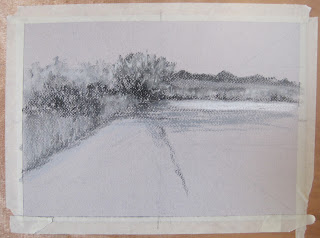We really did have class last Thursday, and it really was of value. (Groan if you must. I couldn't pass that one up.) I've just been tied up and didn't get to the computer to post the results until now.
I'm going to post my notes for you, which don't quite read as a lecture, per se, but should help to get you there.
The Role of Value in Composition and Color
Value before color! Why?
It organizes the painting.
It's the principal visual experience.
In black and white you understand color. In other words, you don’t need color to describe what you see, only tonal values. Value defines the shapes, volume, textures, transitions, movement and contrasts.
An apple without color still has the contour, form, volume and tone as an apple in color.
We hear:
"Use any color as long as the value is right." Is this true?
"The value can go wrong even if the color is right." Is this true?
"Value does the work, color gets the credit." Do you think so?
Value creates a visual pathway. How you mass the values moves the eye.You control the speed with tonal contrast.
Speeds up to get to a strong contrasting value: black next to white.
Slows down in gray areas.
Values make the underlying abstract pattern.
Use three to five value shapes.
Begin with larger, simple shapes first, to organize the painting.
Make them unequal in weight using the size to draw the eye.
Divide them into smaller detailed areas.
Value is built on its surroundings, thus no tone remains independent of is background.
Medium gray when surrounded by dark looks lighter, but when surrounded by light looks darker.
Thus you control the value using its surroundings.
Consider the overall tone of your painting: its Notan—reduced to black and white only.
Fewer values (three to five) often produce a more successful painting. More is not always better.
Value creates the mood of a painting.
Low-key (dark) paintings, using chiaroscuro are dark and dramatic.
High-key (light) paintings create lighter mood.
Use a dominant value.
Value is the underlying motivator of color.
Mass together values and you strengthen color.
Use three to five colors of the same value for strength, beauty.
It’s not more color that makes a painting successful.
It’s understanding the value relationships and how they work together to build the painting.
Color and value are inextricably intertwined. They're very much like a hand in a glove; although the glove exists independently in the material world, it does not function until the hand is inside it. So it is with the glove of color, which needs the hand of value to motivate it. Artists rely on color as one of the fundamental elements of painting. Value is an issue that comes up as the artist advances in skill and consideration of the theory of painting. Value or tone, which is the lightness or darkness of any color, is independent and exists with or without color. It's black and white and all grays in between, as well as all of the dark to light tones of any given color. It's an essential component of any color. You cannot separate color from its value, but you can and should consider value as an issue of primary importance, separate from color.
Understanding value can strengthen color. Most artists use color easily, almost without thinking, far more often than they consider the underlying, driving force of value. This doesn’t mean that they disregard value -- quite the contrary. Value is so intimately linked to color that they seem not to consider the hand apart from the glove. As the artist progresses through her career, value sneaks in, becoming increasingly important. As fundamental as it is, value is often left to the consideration of the more experienced painter. This should not be a surprise since, as in so many other disciplines, the further one goes into the depths the more elemental the concepts become. Still, the most experienced painter can learn new things, which is why art is one of the richest and most varied of pursuits and may continue for a lifetime.
________________________
You'll recall that I referred you to Sally Strand's work in the list of Basic Art Elements I posted in the Emulation Class, urging you to look at the great value structure she uses. She's renowned for her color, but explore it from a value standpoint!
Look at this painting she did, titled 'Awake'. First I reduced it to grayscale:
Analyze how she has massed the dark, medium and light values to move your eye around. Where to do you want to look first? Where does your eye skim over, and where does it linger? Why?
Now look at the same painting reduced to nothing but black and white shapes:
Do you think this is an interesting abstract painting in itself? Are the shapes still compelling and interesting?
And here's the painting in color:
I find that looking at work in grayscale shows the
underlying structure of the painting, while reducing it to purely black and white shapes massed together shows the value structure
as an abstraction. If this is good, the painting is more likely to succeed.
(Thanks so much for allowing me to use your painting, Sally!)
Click here to enjoy more of Sally's work.
____________________________
The assignment was to make a finished black-and-white piece. This is a drawing I did in pencil, on an 8x11" piece of bristol board:
I saw some good work going on, this among them:
 |
| Gina's pastel |
|
|
Looking good! Keep painting, gang!
Deborah











